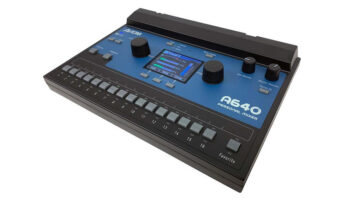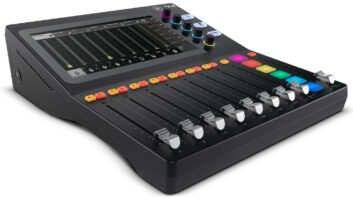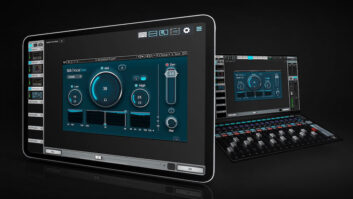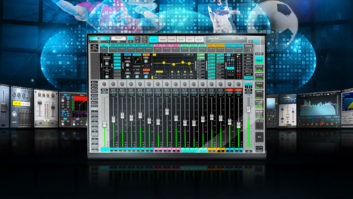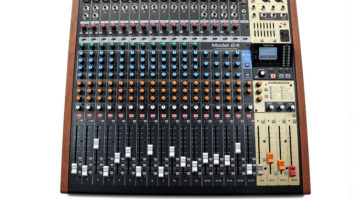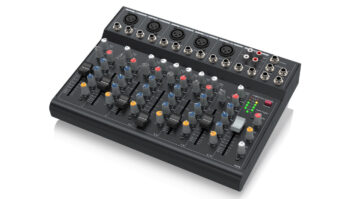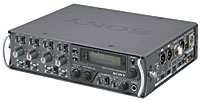
HEATED LCD, HOT DESIGN
Sony is no stranger to video production. In fact, Sony has the whole
signal production chain pretty much covered. For the field mixer niche,
Sony created the DMX-P01, a portable digital mixer with a few extra
features that will land Sony right in the heart of the field mixing
market.
DMX-P01 IN THE FIELD
The DMX-P01 ($2,800) is a 24-bit/96kHz mixer with AES/EBU and S/PDIF
outputs. It has four microphone/line inputs with gain controls, phantom
power and two balanced analog outputs, and comes equipped with digital
limiters, compressors and an LCD for checking levels and settings. The
LCD can be selected to be heated, so it also works in cold
temperatures. The DMX-P01 features digital cascading for linking two
DMX-P01s and scene recall, something not usually offered on a field
mixer. It’s lightweight and runs on eight AA batteries or from an
optional AC adapter. It comes with two battery packs that should get
you though a typical day of shooting. The unit is wrapped in an
attractive metallic shell that is reminiscent of its VAIO line of
computers. Engineers will mourn the first nick and scrape to their
DMX-P01, much like a scuff on a cool new pair of shoes. I’d rather see
the money go toward the controls vs. the aesthetics, but more on that
later.
We used the DMX-P01 primarily in a field production setting. For
simple run ‘n’ gun news gathering, this mixer might be overkill —
and in some cases, inhibiting — without previous mastery of the
controls. The menu-driven control panel is straightforward but not
ideal in a pressure situation. It’s like choosing settings on any piece
of digital gear: Turn a dial, find a setting, press the dial. Analog
controls are the easiest to access, of course, but a menu is required
to navigate the added features of the DMX-P01. The low-cut filter is
adjustable from 50 Hz to 400 Hz at typical increments, and offers A and
B settings for each channel. Scene recall could come in handy for an
audio engineer who works the circuit on a variety of shows with the
same folks. In general, Sony did a nice job of adding menu-driven
features, keeping the design straightforward.
When I work with production crews, the typical mixers in the arsenal
are made by Cooper, Audio Designs, PSC, Shure, etc. Sound engineers
usually spend a lot of time getting to know their mixer, and become
comfortable with a certain piece of gear over time. The harsh reality
is, with a lot of broadcast and cable TV programming, audio is the
second priority after shooter, camera and format. However, the DMX-P01,
when mastered, could provide an advantage in setup time and possibly be
used as a selling tool.
The DMX-P01 is similar to a Cooper CS104 in layout. Access to
controls, filters and most everything besides the I/O can be found on
the top face. That means no hunting around the bottom and side panels
for settings. The unit is as sturdy as you’d expect a field mixer to
be; many of the switches are protected in curved recessed slots. This
design helps to prevent the accidental bump of a setting. However, I’d
like to see more steel on some of the controls. The input level knobs
appear especially vulnerable, as they protrude from the unit the most.
Sony’s design staff may have won out over the engineers on this one.
Overall, the feel is good and most everything is accessible.
I’m not a huge fan of using an LCD panel for setting levels and
tweaking settings — I find the process a bit cumbersome. But the
reality is, once the settings are made, most of the action takes place
on the analog level controls anyway — just a matter of comfort
level. The good news, though, is the LCD is accurate and works well
with the headphone mix: What you see is actually what you get.
IT’S A WRAP
The digital guts in this mixer enable more ways to tweak the signal
and pass it around to other equipment. For example, while shooting a
home improvement show, the versatile low-cut filters came in handy for
removing low-frequency energy from the sound of leaf blowers off in the
distance and the general hum of a nearby street. As for the Scene
Recall feature, you would have to work in a very consistent sonic
environment to get a lot of value from it — for example, it could
come in handy for remote recording of bands.
The DMX-P01 did everything I needed it to do, and sounded great. Its
clean design was easy to get around. It appears well made and
road-worthy apart from a few plastic knobs. It offers a multitude of
ways to capture and distribute audio in both analog and digital
environments. It would be hard to justify the cost of this mixer for a
run ‘n’ gun shooting team that’s already using something tried and
true. However, the DMX-P01 competes well in the upper echelon of what’s
being offered. When serving clients who believe audio is just as
important as video, Sony’s DMX-P01 could help you win business.
Sony Pro Audio, 800/686-7669, www.sony.com/professional.
Rick Spence is the owner of AVT Pro, a production company in the
Silicon Valley.
